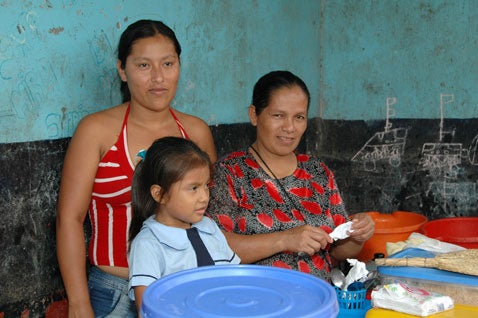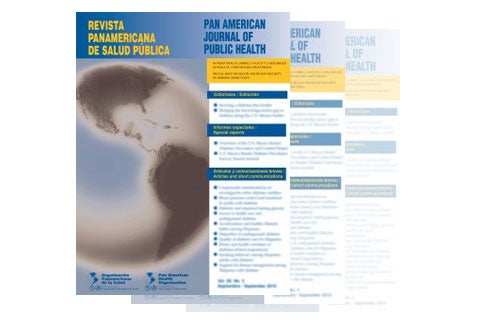

Despite worldwide efforts by public health advocates to strengthen legislation on violence against women, most existing laws fail to fully promote prevention and ensure adequate support and care for women who are victims of violence, according to a special...
Special report published in the latest issue of the Pan American Journal of Public Health
Washington, D.C., 22 February 2013 (PAHO/WHO) — Despite worldwide efforts by public health advocates to strengthen legislation on violence against women, most existing laws fail to fully promote prevention and ensure adequate support and care for women who are victims of violence, according to a special report, "Legislation on violence against women: overview of key components," published in the latest issue of the Pan American Journal of Public Health.

Analyzing legislation on women and violence in 80 countries and territories worldwide, the authors compare existing laws with recommendations from the Pan American Health Organization and the United Nations. They find that most countries' laws fall short of adhering to key recommendations regarding definitions of violence, identification of women as beneficiaries of protection or support, roles for multiple sectors (judicial sector and police but also education and health, e.g.) in interventions related to violence against women, and terms used (such as "violence against women" vs. "domestic violence"). Previous studies have shown that legislation that refers to "domestic violence," "intra-family violence," or "family violence" rather than "violence against women" tends to prioritize the stability of the family over the rights of women.
Laws on violence against women in the Americas fare better than laws in other regions, according to the report. Most countries and territories in the Americas included key recommended components in their violence against women legislation, and most legislation that included the term "violence against women" in the title was enacted in the Americas.
The authors conclude overall that "significant limitations were found in the legislative content, its application, and the extent to which it provided women with integrated protection, support, and care. In developing new [violence against women] legislation, policymakers should consider the vital role of health services."
Also in this issue, "The Bolsa Família cash transfer program and food and nutrition security in Brazil: a critical review of the literature" reviews previous studies on Brazil's Bolsa Familia program. The authors report that five studies show that Bolsa Familia has a positive impact on the food and nutrition security of participating families. However, three studies show increased consumption of high-calorie, low-nutritional value foods. The authors conclude that cash transfer programs can contribute more effectively to the nutritional well-being of participants if they are combined with other types of interventions, such as actions to promote healthy eating.
"The cholera epidemic in Latin America: reemergence, morbidity, and mortality" analyzes morbidity, mortality, and case-fatality in cholera outbreaks in 18 Latin American countries during 1991 to 2011. The authors find that the most affected countries were Peru (1991 to 2002), with a peak annual incidence of 1,452.72 cases per 100 000 population but a low case-fatality rate (0.72%), and Haiti (2010 and 2011), with a peak annual incidence of 3 319.13 per 100 000 population and a case-fatality rate of 1.32%. The article concludes that cholera has resulted in high morbidity, mortality, and case fatality in some Latin American countries, due largely to socioeconomic and climatic factors, and that the disease's reemergence calls for stronger regional prevention and control strategies.
Other articles in this issue include:
- "Key elements in implementing adverse event notification systems in Latin American hospitals"
- "Geographic distribution of wild rabies risk and evaluation of the factors associated with its incidence in Colombia, 1982-2010"
- "HIV testing rates among pregnant women in Managua, Nicaragua, 2010—2011"
- "Tuberculosis in indigenous peoples in the Brazilian Amazon: an epidemiological study in the Upper Rio Negro region"
- "Validity and reliability of the Argentine version of the PCAT-AE for the evaluation of primary health care"
- "Hospital self-management policy in Chile: perceptions of decision-makers"
- "National prevalence survey in Brazil to evaluate the quality of microbiology laboratories: the importance of defining priorities to allocate limited resources"
The Pan American Journal of Public Health (PAJPH) is an open-access, peer-reviewed monthly journal of PAHO/WHO. Its mission is to disseminate scientific public health information to strengthen national and local health systems and improve the health of the peoples of the Americas.
Links:
- Pan American Journal of Public Health, January 2013 (Vol. 33, No. 1)
- More information about the Pan American Journal of Public Health
- http://www.paho.org/paho110/
- http://www.paho.org
- https://www.facebook.com/PAHOWHO
- https://www.youtube.com/pahopin
- https://twitter.com/pahoeoc
- https://twitter.com/pahowho
- https://twitter.com/opsoms
Media Contacts:
Leticia Linn, linnl@paho.org, Tel. + 202 974 3440, Mobile +1 202 701 4005, Donna Eberwine-Villagran, eberwind@paho.org, Tel. +1 202 974 3122, Mobile +1 202 316 5469, Sebastián Oliel, oliels@paho.org, Phone +1 202 974 3459, Mobile 202 316 5679, Knowledge Management and Communications, PAHO/WHO—www.paho.org



